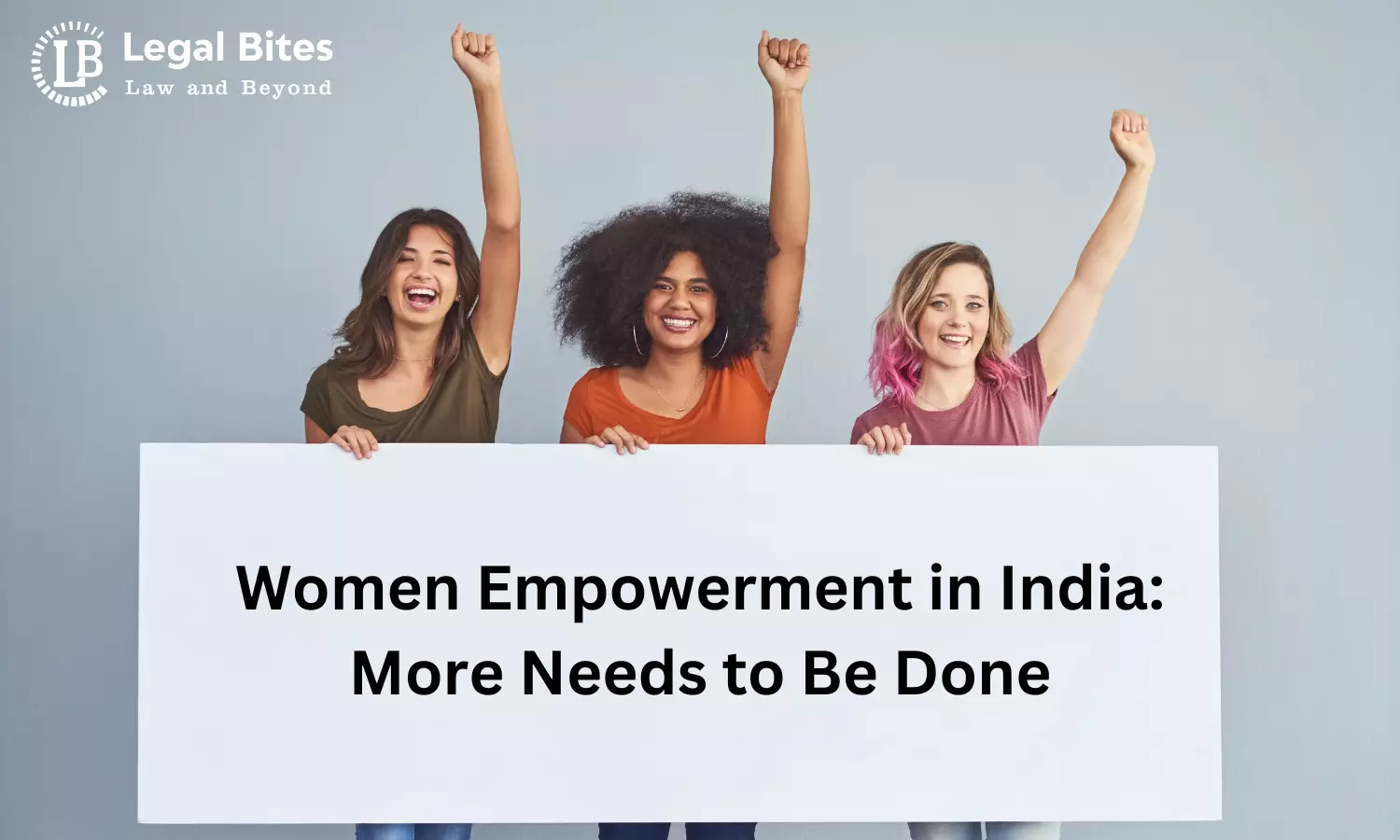Women Empowerment in India: More Needs to Be Done
The article 'Women Empowerment in India: More Needs to Be Done' by Snehil Sharma deals comprehensively with the historical background, legislative framework at the national level, notable changes, and existing challenges of empowering women in India.

The article 'Women Empowerment in India: More Needs to Be Done' by Snehil Sharma deals comprehensively with the historical background, legislative framework at the national level, notable changes, and existing challenges of empowering women in India.
The women's empowerment programmes are crucial for making significant investments in the welfare and empowerment of women and further empowering them to reject gender stereotypes and step beyond of their customary positions. It's necessary to break down barriers and investigate alternative programmes for supporting equal opportunities for women and fostering financial inclusion in order to keep up with shifting global trends.
Introduction
The phrase "women empowerment" refers to authority or the power vested in women who share equivalent rights. The phrase describes the emancipation of women from socioeconomic dependence. Most of the women in the nation—roughly 50% of the total population—remain economically reliant on one another even in the absence of employment. In the era of feminism, certain women in India are liberated, can exercise their free will, and are allowed to live the lives they choose. But there is a sizable segment of women in this country who need upbeat encouragement. Women are still not allowed to receive a basic education in the majority of Indian villages and semi-urban areas, despite having acquired the necessary knowledge.
Women are regarded as the foundation of every culture since they can do multiple duties with ease each and every day. Women play a variety of responsibilities in civilizations where men predominate, including devoted mothers, caring daughters, and competent coworkers. The glorious thing about them is that they excel in every capacity. However, they have also been regarded as a group of society that has been ignored in various parts of the world.
Brief History
Gender discrimination has been a matter of debate since the times of ancient India. Making girls marry at an early age was the ideal mentality of society. However, this situation was unusual and unique because, while the daughters had the freedom to select their husbands, they also had to practice Sati. As women were regarded similarly and on par with men in the West throughout the British era, there were many adjustments and advancements made in this regard. Savitribai Phule became India's first female educator in 1848. Women now have the confidence to escape the grasp of many forms as a result of this.
Women's empowerment was the top priority for numerous social reformers and freedom fighters while the struggle for freedom was still ongoing. Many social reformers, including Raja Ram Mohan Roy, Iswar Chandra Vidyasagar, and even Mahatma Gandhi, advocated for women's education as well as the elimination of sati and the prohibition of child marriage, among other social standards.
The Sati Act of 1829, the Hindu Widow Remarriage Act of 1856, the Child Restraint Act of 1929, the Women's Right to Property Act of 1937, and other reforms were made as a result of this national upheaval. After independence, women's status in society began to improve. To protect women from all types of social injustice, laws like the Hindu Marriage Act of 1955, the Hindu Adoption and Maintenance Act of 1961, the Dowry Prohibition Act of 1961, etc., were put into place.
Various Legislative Enactments and its role
Due to the injustices women endured in Indian society, Indian women were not aware of what freedom or independence feels like until the legislative frameworks were established with the intent to bring substantial changes. These changes were made in all areas of their life, since ensuring justice and equality for women was very crucial. It was made sure that women's equality is guaranteed and State is introducing several programmes for their advantage. A few of the legislative frameworks are as follows:
1) Indian Constitution
The Indian Constitution's Preamble, Fundamental Rights, Fundamental Duties, and Directive Principles all explicitly state the importance of gender equality. In addition to guaranteeing women's equality, the Constitution gives the State the authority to implement measures that positively discriminate in favour of women. Our laws, development strategies, plans, and programmes have all been created within the context of a constitutional democracy with the goal of advancing women in a variety of fields. The right to work with dignity and protection from sexual harassment are both aspects of gender equality that are universally acknowledged as fundamental human rights.
2) Indian Penal Code
As part of its efforts to respect the Constitution's mandate, the State has passed a number of laws that guarantee equal rights, combat social discrimination, various forms of violence, and atrocities, and offer support services, particularly to working women. Women may be victims of any crime, including murder, robbery, and infidelity, but crimes that are expressly targeted against women are known as crimes against women. These crimes include Rape (Section 376 IPC), Torture, both mental and physical (Section 498-A IPC), Molestation (Section 354 IPC), Kidnapping & Abduction for different purposes (Section 363-373), Sexual Harassment (Section 509 IPC), Homicide for Dowry, Dowry Deaths or their attempts (Section 302/304-B IPC), Importation of girls (up to21 years of age), etc.
The need for special laws is periodically reviewed and existing laws are amended that can significantly affect women in order to keep up with the new types of crimes. Several laws specifically designed to protect women and their interests include the following:
1) The Sexual Harassment of Women at Workplace (Prevention, Prohibition and Redressal) Act, 2013: The Vishaka Guidelines were established by the court in the case of Vishaka v. State of Rajasthan (1997). The Sexual Harassment of Women at Workplace (Prevention, Prohibition and Redressal) Act, 2013, was later based on these ideas. To guarantee that women feel safeguarded at their place of work, this Act was passed.
2) Indecent Representation of Women (Prohibition) Act, 1986: This legislation was introduced to restrict the indecent portrayal of women in publications, writings, paintings, figures, and other media, as well as for issues related to or incidental to the bill.
3) The Dowry Prohibition Act, 1961: The Indian government passed the Dowry Prohibition Act on May 1, 1961, with the goal of outlawing the giving or receiving of dowries. According to the Dowry Prohibition Act, dowry is any property, products, or cash given to marriage by either party, by either party's parents, or by any other person in association with the marriage.
4) The Medical Termination of Pregnancy Act, 1971: This law was passed to outlaw the practise of performing unlicensed abortions. The procedures through which a pregnancy may be ended or aborted are mentioned in this Act.
5) The Prohibition of Child Marriage Act, 2006: The Act's primary objective is to forbid child marriages as well as related and incidental issues. The Government of India replaced the previous law, the Child Marriage Restraint Act 1929, with the Prevention of Child Marriage Act 2006 to ensure that child marriage is completely eliminated from society.
Notable Gains in Woman Empowerment
India has seen both highs and lows on its path to empowering women. By ratifying international agreements and creating local regulations aimed at putting an end to gender inequity, it has progressed. In order to empower women from all socioeconomic backgrounds, the government has opened the door for foreign organizations to collaborate with state governments, local non-government organizations, and private businesses on a wide range of programmes.
India has achieved substantial progress in improving the lives of its women through better access to family planning services, better health and educational facilities, and more engagement of women in local governance. The Government has made a commitment to recognize women's empowerment and gender equality as the cornerstones of numerous cross-cutting strategic policy areas.
Existing Challenges in Woman Empowerment
India has made progress toward human development, but it still ranks poor internationally in terms of gender equality. India dropped from 108th to 112th place in the World Economic Forum's Global Gender Gap Report from 2018 to 2020. India has succeeded in narrowing the gender gap by two-thirds overall, particularly in areas of political empowerment. Given that a woman led the government for 20 years, it received a ranking of 18 on the Political Empowerment sub-index. However, the overall political representation in India is rather low, with women making up only 23% of the cabinet and 14.4% of the parliament.
Additionally, there are discrepancies between policy and practice in the Indian legal system. Even while there is legislation in place to protect women and girls, there are still problems with its implementation and the conviction of alleged offenders. Corrupt practices and systematic bureaucracy deepen the gaps in these procedures.
The infamous "Nirbhaya" gang rape case's offenders were hanged after seven years. The issue of women's empowerment being less apparent in rural India than in metropolitan areas is yet another hindrance. Given that the rural population in India is approximately 65.97% despite rising urbanization and the expansion of cities, which should be of great concern. Women have more access to healthcare, career opportunities, education, and decision-making in metropolitan settings.
Conclusion
India's journey toward women's empowerment and gender equality began in 1947 when it attained independence. Even though there have been noticeable improvements in the areas of grassroots initiatives, human development, and legal reforms, New Delhi still has a long way to go in many areas of women's empowerment.
To bridge the urban-rural divide and guarantee that rural women have equal access to healthcare, employment, education, and decision-making as their urban counterparts, more coordinated efforts are required. Since many of the obstacles to women's empowerment are attributed to patriarchal and patrilineal traditions that are ingrained in many South Asian civilizations, changing attitudes will be the most difficult challenge.
References
1) National Policy for The Empowerment of Women (2001), Available Here
2) Hira Saeed, 5 Ways We Can Empower Women Globally, Available Here
3) Roshni Kapur and S Narayan, Women Empowerment in India: More needs to be done, Available Here
4) Dilip Chenoy, A brief history of women empowerment in India, Available Here
5) Isha Arun Mudbidri, all you need to know about women empowerment in India, Available Here
Important Links
Law Library: Notes and Study Material for LLB, LLM, Judiciary, and Entrance Exams

